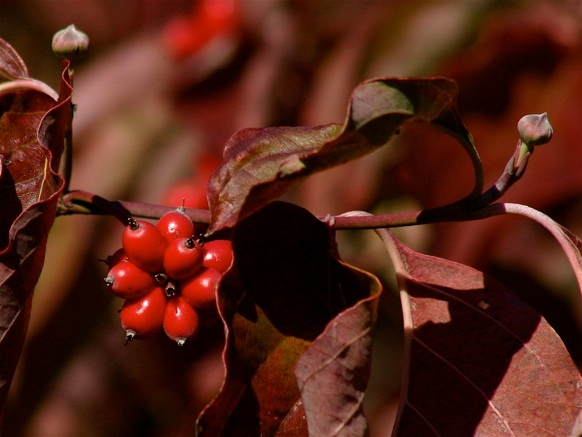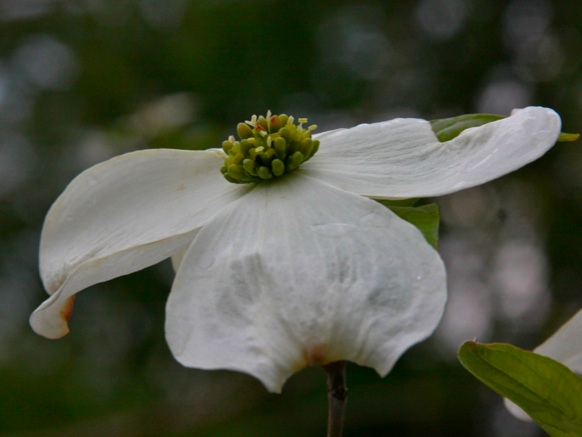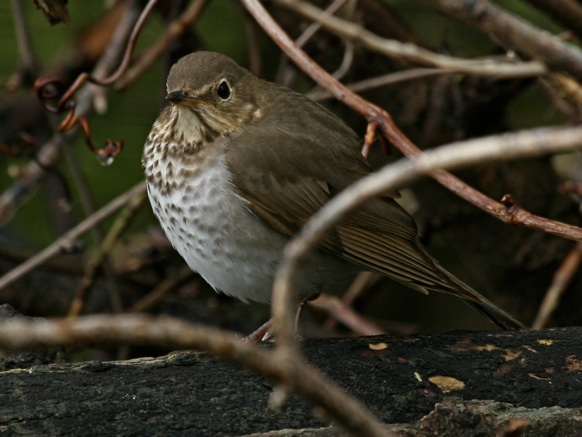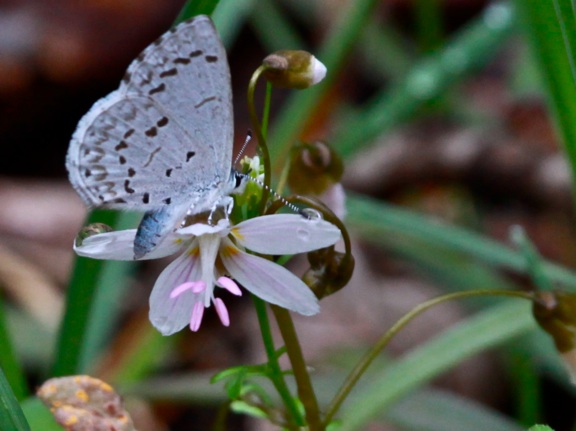The Nature
Observer’s Journal
The Nature
Observer’s Journal

May Day, May Day,
the Dogwoods are in bloom!
Chuck Tague
This week the Flowering Dogwood, Cornus florida: Family Cornaceae, should peak in western Pennsylvania. This colorful understory tree’s blossoms will change from cream to pure white, a sure sign that the other forest wildflowers are at their best and waves of songbirds migrating from the American tropics are about to touch down.

In fall the leaves change to bronze and the fruit ripens to a shiny scarlet.
Flowering Dogwood with its attractive blooms is a familiar tree from southern Pennsylvania to Florida. Without the blossoms, however, how do you recognize a Flowering Dogwood? (By the bark, of course.) There are many clues. In the summer the opposite, egg-shaped leaves help to identify Flowering Dogwood. In the fall the leaves change to bronze as the oval fruit, a drupe containing one seed, turns bright scarlet. In winter the conspicuous turban-shaped end buds are a give away.
However, during all seasons to identify the dogwood, you must know its bark, (seriously). The trunk is invariably crooked and the bark is a blotchy pattern of deeply furrowed gray squares of varying sizes that resembles alligator hide.

Dogwoods have four petal-like bracts.
The flowers are clustered in the center.
A trick question to ask someone who is not a skilled observer of nature is “what color are the flowers on a dogwood?” The answer is green. The bright white “petals” are bracts -- leaf-like structures that grow below flowers on many plants. On the Flowering Dogwood, the colorful bracts attract insects to the small yellow-green flower clusters in their center. Usually there are about twenty flowers in each flower head.

During the winter the end bud on the twigs protect the cells that produce these flowers and bracts. A quarter-inch high and shaped like a Hershey Kiss (the end buds are easily spotted after the autumn leaf drop). In spring the scales of these buds stick to the four emerging bracts. These scales are responsible for the blotches that resemble drops of blood on the tips of the cross-shaped bloom. In the south Dogwoods bloom earlier. The resemblance of the dogwood’s bloom to a blood stained cross is a graphic Easter symbol.
In the last two and a half decades an introduced fungus, Discula destructiva, has decimated Flowering Dogwood populations across its range. This fungus spreads a disease called Dogwood Anthracnose. Pennsylvania’s dogwoods have been very hard hit. An estimated 75% of C. florida in the Commonwealth have died either directly or indirectly from the disease. There is some evidence that the remaining dogwood trees are showing some resistance to the disease.
According to Chuck Fergus in Trees of Pennsylvania and the Northeast, (Stackpole Books, 2002) the loss of so many Flowering Dogwoods has had several ecological consequences to our forest community. Birds, especially thrushes, depend on the high-fat dogwood fruit to fuel their migration to the tropics. At least 35 species of birds are known to eat Flowering Dogwood fruit.

Swainson’s Thrushes coordinate their autumn migration with the ripening of dogwood fruit to build up energy reserves for their long journey to South America.
Some studies have noted Spicebush and Black Gum increase as C. florida disappears. These two understory species also have high-energy fruit favored by migratory songbirds.
Dogwood leaves are high in calcium and as they slowly break down they provide a valuable mineral to forest animals. The decrease of the dogwood population and the calcium it cycles affects invertebrates such as snails as well as the birds, small mammals, toads and salamanders that eat these creatures. There is concern that the nesting success of forest songbirds has dropped because of this sudden decrease in calcium.

Spring Azure on a Spring Beauty
Dogwood flowers are the food source for the caterpillars of the Spring Azure. These bright blue dime-sized butterflies are one of the first to fly in the spring. Their population peaks about the time Flowering Dogwood buds start to spread.
Click on the photo to view a slideshow of Flowering Dogwood’s seasonal transitions.
Sunday, May 1, 2011
